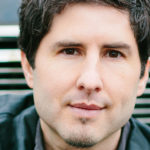By Kirsten Miller
As technology and the internet take over as the preferred research tools for students, high school media centers look quite different these days.“It’s about staying on top of what kids want and need, which changes rapidly,” said Carol Tracy, Armstrong High School library media specialist, who spearheaded the school’s recent media center transformation.

The media center now, after a transformation that included more user-friendly tables, chairs and other seating areas for students to study, collaborate, and socialize. (Sun Sailor staff photo by Kristen Miller)
When she came to Armstrong three years ago from the School of Engineering and Arts in Golden Valley, Tracy described the media center as a “warehouse of old books and computers.”

The media center before the transformation began last school year. More than 10,000 outdated books, and the free-standing bookshelves, were eliminated to make way for tables and chairs. (Submitted photo)
“I think libraries, in general … need to respond to what the needs of the community are, and try to cater to students’ strengths,” Tracy said.
For Tracy, it was about creating a space, “where kids can manage their time and their environment on their own,” to better prepare them for the transition into college. That meant creating a space more like a student union and less like the traditional quiet library.
The first phase of the transition took place last school year as part of a $64,000-grant from the federal Library Services and Technology Act, which was shared with Cooper High School. The phase included eliminating approximately 10,000 outdated books and free-standing bookshelves. The school’s implementation of the one-to-one Chromebooks, allowed for the elimination of some of the desktop computers. This freed up space for furniture, such as couches, sofas, and coffee tables, in order to make more collaborative spaces for students.
“We’ve made it less of a warehouse of textbooks and library books, and more of a flexible learning space,” Tracy said.
The majority of the students utilizing the media center on a daily basis are doing so during their study halls, whereas otherwise they would be in a classroom. This was implemented as part of the first phase, Tracy noted.

Working on the new Maker Space 3D printer are students Liz Shapiro, Ben Opem, and Matt Wallace. (Sun Sailor staff photo by Kristen Miller)
Because the media center provides a freedom for students to use the time as they wish, it doesn’t come without responsibility. Students must maintain passing grades in all their classes or their media center pass is rebuked. To manage this, each student must check in at the media center desk at the beginning of the period.
The second phase was recently completed, thanks to a $60,000 grant (also shared with Cooper) through the Seven Dreams Education Foundation. The money was raised in February at the annual Bird Bash.
With this grant, additional furniture was purchased, including movable and adjustable tables, and a mobile computer monitor (with a Chromebook hookup). It was important to provide a variety of furniture for different uses, Tracy noted.
The media center looks very different from period to period, Tracy said, referring to how students and teachers utilize the space differently throughout the day.
This grant also helped purchase Maker Space equipment and technology to further cater to students’ talents, such as a 3D printer, Mac computer with design and editing software, and some video production equipment, such as a green screen.

One of the goals to the media transformation was to cater to students’ strengths, whether it’s technology, video, or music. As part of the new Tiny Desk Concert program, Armstrong sophomore Jessa “Kat” Hanson works on a song with Katy Tessmann, media clerk. (Sun Sailor staff photo by Kristen Miller)
“Students have really responded to the new space,” Tracy said, noting that prior to the first phase, the media center garner approximately 100 visitors per day. Now, there are more than 500 student visitors utilizing the media center each day.
“They really love being in here,” Tracy said of the students. A testament to that was evident when the media center was recently closed for MCA testing. “You would think we were depriving them of oxygen,” Tracy said.
Armstrong students Deborah Guerrero and Angelica Sinchi like the relaxed, comfortable space they find in the media center, as opposed to being in a classroom study hall.
“I feel like I’m actually normal for once,” Sinchi said, noting how the school can make her feel imprisoned at times throughout the day.
PROVIDING AN OUTLET FOR STUDENT CREATIVITY
Part of the transformation was also to provide students the time, space, and tools to use their own innate creativity.
By providing the additional Maker Space technology and equipment, such as the 3D printer and Mac computer, students can explore outside their normal curriculum.
“It really allows kids to explore different avenues of creativity,” said Sean Beaverson, Armstrong’s technology integrative specialist.
A product of that creativity has been the production of Armstrong TV, which first aired in late September.

The media center transformation also added a live help desk after the school went one-to-one with Chromebooks last year in which students help students with Chromebook issues. Here, Armstrong freshman Amiin Ali replaces a broken screen on a classmate’s Chromebook. (Sun Sailor staff photo by Kristen Miller)
Beaverson and Tracy had discussed how some of the technology could best be utilized, such as the Mac with design and editing software, and the idea of a student-lead television program came to mind when Armstrong senior and film-maker Gabe Hostetler walked in. They knew they only had Hostetler’s talents for one more year, and this would be an opportunity to capture his talents and leave his legacy.
“He provided us with a vision that was easy to get behind,” Beaverson said, which was a student-driven television program with a goal of “deepening the understanding of the entire school community.”
“He was very intentional about it,” Beaverson said, in that “if people know more about each other, it strengthens the school community.”
With additional grant money, they were able to purchase a green screen, microphones, and lights to assist with the production.
Hostetler and the Armstrong TV crew, Shawn Daye, Nicole Hults, and Papa M’Bye, Nate Casey and Hannah Sedqi, have created 10 episodes, providing highlights on athletics and fine arts, as well as additional commentary and interviews with staff and students.

The mastermind behind the media center transformation is Carol Tracy, library specialist, with students Deborah Guerrero and Angelica Sinchi . (Sun Sailor staff photo by Kristen Miller)
“The media center here has just been great,” said Hostetler, who plans on earning a degree in film production. “It’s given me time to work on my craft and grow.”
Armstrong TV is just one of the many ways Tracy sees students thriving with the new space and technology. “If you give [students] the tools, time, and the space to work, they will do brilliant things,” Tracy said.
Contact Kristen Miller at Kristen.Miller@ecm-inc.com.






